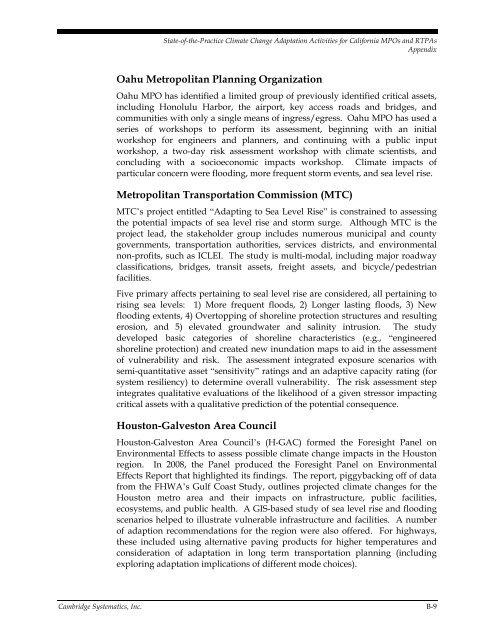addressing climate change adaptation in regional transportation plans
addressing climate change adaptation in regional transportation plans
addressing climate change adaptation in regional transportation plans
Create successful ePaper yourself
Turn your PDF publications into a flip-book with our unique Google optimized e-Paper software.
State-of-the-Practice Climate Change Adaptation Activities for California MPOs and RTPAsAppendixOahu Metropolitan Plann<strong>in</strong>g OrganizationOahu MPO has identified a limited group of previously identified critical assets,<strong>in</strong>clud<strong>in</strong>g Honolulu Harbor, the airport, key access roads and bridges, andcommunities with only a s<strong>in</strong>gle means of <strong>in</strong>gress/egress. Oahu MPO has used aseries of workshops to perform its assessment, beg<strong>in</strong>n<strong>in</strong>g with an <strong>in</strong>itialworkshop for eng<strong>in</strong>eers and planners, and cont<strong>in</strong>u<strong>in</strong>g with a public <strong>in</strong>putworkshop, a two-day risk assessment workshop with <strong>climate</strong> scientists, andconclud<strong>in</strong>g with a socioeconomic impacts workshop. Climate impacts ofparticular concern were flood<strong>in</strong>g, more frequent storm events, and sea level rise.Metropolitan Transportation Commission (MTC)MTC’s project entitled “Adapt<strong>in</strong>g to Sea Level Rise” is constra<strong>in</strong>ed to assess<strong>in</strong>gthe potential impacts of sea level rise and storm surge. Although MTC is theproject lead, the stakeholder group <strong>in</strong>cludes numerous municipal and countygovernments, <strong>transportation</strong> authorities, services districts, and environmentalnon-profits, such as ICLEI. The study is multi-modal, <strong>in</strong>clud<strong>in</strong>g major roadwayclassifications, bridges, transit assets, freight assets, and bicycle/pedestrianfacilities.Five primary affects perta<strong>in</strong><strong>in</strong>g to seal level rise are considered, all perta<strong>in</strong><strong>in</strong>g toris<strong>in</strong>g sea levels: 1) More frequent floods, 2) Longer last<strong>in</strong>g floods, 3) Newflood<strong>in</strong>g extents, 4) Overtopp<strong>in</strong>g of shorel<strong>in</strong>e protection structures and result<strong>in</strong>gerosion, and 5) elevated groundwater and sal<strong>in</strong>ity <strong>in</strong>trusion. The studydeveloped basic categories of shorel<strong>in</strong>e characteristics (e.g., “eng<strong>in</strong>eeredshorel<strong>in</strong>e protection) and created new <strong>in</strong>undation maps to aid <strong>in</strong> the assessmentof vulnerability and risk. The assessment <strong>in</strong>tegrated exposure scenarios withsemi-quantitative asset “sensitivity” rat<strong>in</strong>gs and an adaptive capacity rat<strong>in</strong>g (forsystem resiliency) to determ<strong>in</strong>e overall vulnerability. The risk assessment step<strong>in</strong>tegrates qualitative evaluations of the likelihood of a given stressor impact<strong>in</strong>gcritical assets with a qualitative prediction of the potential consequence.Houston-Galveston Area CouncilHouston-Galveston Area Council’s (H-GAC) formed the Foresight Panel onEnvironmental Effects to assess possible <strong>climate</strong> <strong>change</strong> impacts <strong>in</strong> the Houstonregion. In 2008, the Panel produced the Foresight Panel on EnvironmentalEffects Report that highlighted its f<strong>in</strong>d<strong>in</strong>gs. The report, piggyback<strong>in</strong>g off of datafrom the FHWA’s Gulf Coast Study, outl<strong>in</strong>es projected <strong>climate</strong> <strong>change</strong>s for theHouston metro area and their impacts on <strong>in</strong>frastructure, public facilities,ecosystems, and public health. A GIS-based study of sea level rise and flood<strong>in</strong>gscenarios helped to illustrate vulnerable <strong>in</strong>frastructure and facilities. A numberof adaption recommendations for the region were also offered. For highways,these <strong>in</strong>cluded us<strong>in</strong>g alternative pav<strong>in</strong>g products for higher temperatures andconsideration of <strong>adaptation</strong> <strong>in</strong> long term <strong>transportation</strong> plann<strong>in</strong>g (<strong>in</strong>clud<strong>in</strong>gexplor<strong>in</strong>g <strong>adaptation</strong> implications of different mode choices).Cambridge Systematics, Inc. B-9
















